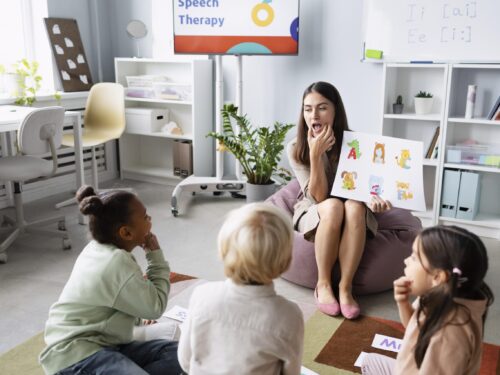How Bilingual Therapy Supports Language Development In Children With Autism
Autism Spectrum Disorder (ASD) affects how children communicate, interact socially, and develop language. Many children with autism experience speech delays or struggle to use language effectively in daily situations. A common myth is that bilingualism confuses children with autism, but research shows it does not hinder their development. In fact, Bilingual Therapy can help children with autism build communication skills in both languages when applied appropriately. Speech therapy for Autism in Singapore often includes evidence-based methods such as Verbal Behaviour Therapy, which encourages functional language through positive reinforcement.
At AUTISMSTEP, a leading provider of Verbal Therapy for Autism in Singapore, therapists tailor interventions to each child’s unique needs and build real-world communication skills for everyday life.
Understanding The Core Language Development Challenges In Autism:
For children on the autism spectrum, learning how to use language to express needs, connect with others, and build relationships can be quite complex due to the diverse communication challenges they face, like delayed speech, limited social use of language, or difficulty understanding cues.
Some children may struggle to form words or combine them into meaningful sentences, making it harder to communicate effectively. Others may develop speech but struggle with pragmatic language, meaning they have difficulty using language socially—such as starting conversations, responding appropriately, or understanding tone and body language. Repetitive speech patterns, such as echolalia (repeating words or phrases), are also common. While echolalia can sometimes serve a purpose in early development, it can also signal a need for more structured language support. However, these challenges vary greatly from child to child, which is why tailored approaches are essential.
Early intervention is a key factor in improving outcomes. The sooner a child receives support that matches their unique communication profile, the better the chances of building lasting verbal and nonverbal skills. Therefore, programs that focus on language development for autism need to be flexible and tailored to each child’s unique needs. However, to be truly effective, they must also include the child’s full linguistic and social environment.
From Home To School: 6 Reasons Bilingual Therapy Works For Language Development
Bilingual Therapy helps children develop communication skills in both their native and formal school language, while also deepening cultural ties and strengthening family relationships. Rather than limiting a child to a single language, combining evidence-based methods with bilingual support can lead to better outcomes. Below are the 6 ways in which Bilingual Therapy, especially when integrated with approaches like ABA-VB Therapy and Verbal Behaviour Therapy, can support language development.
1. Builds Functional Communication in Both Languages
Bilingual Therapy equips children to use both of their spoken languages for real, everyday communication—whether asking for help, expressing how they feel, or sharing what they want. This is essential for children who may speak one language with family members and another at school or during therapy. Rather than favouring one language over the other, Bilingual Therapy supports both, allowing the child to engage fully in all areas of life without causing confusion or disconnect between home and learning environments.
2. Supports Natural Language Use Across Settings
Children often benefit from learning how to shift between languages depending on their environment. Techniques from ABA-VB Therapy reinforce language use through consistent, meaningful practice across daily situations, helping the child generalize speech in both languages. This cross-context flexibility is key to building real-world communication, not just scripted responses.
3. Enhances Cognitive Flexibility and Understanding
Being exposed to more than one language can help boost mental adaptability, which is often a challenge for children with autism. When combined with ABA-VB Therapy, this flexibility helps children shift between tasks, interpret meaning more effectively, and respond in socially appropriate ways. Over time, this contributes to stronger overall language development and improved interaction skills.
4. Prevents Language Loss and Strengthens Cultural Identity
When therapy is delivered only in one language, often the dominant societal language, it can lead to the loss of a child’s home language, which weakens ties to their culture and family history. Bilingual Therapy actively prevents this by helping the child maintain communication in both languages, ensuring they don’t lose the ability to talk to grandparents, siblings, or caregivers who may not speak the school language. This also reinforces a stronger sense of cultural pride and belonging, which is vital for self-esteem and social development.
5. Customises Reinforcement Across Languages
Therapists can use ABA-VB Therapy methods to tailor reinforcement strategies across both languages the child understands and speaks. Whether it’s verbal praise, a favourite toy, or a social reward, the goal is to strengthen desired communication behaviours across settings. These tailored reinforcements ensure progress is consistent, no matter which language is being used.
6. Empower Families to Be Active Partners
Bilingual therapy supports children in learning both school and home languages, while enabling parents to reinforce their speech development through everyday interactions. With guidance from therapists, families can learn simple ABA-VB Therapy techniques that fit naturally into everyday routines—like during meals, play, or getting ready for bed. Being able to use these strategies in their native language makes parents feel more confident and involved. It turns the home into an extension of therapy, where consistent, meaningful communication practice can happen every day.
Summary:
Bilingual Therapy, when combined with proven strategies like ABA-VB Therapy and Verbal Behaviour Therapy, offers a powerful, inclusive approach that supports real communication in both home and school environments. By strengthening language skills across both settings and involving families every step of the way, this approach builds lasting progress and deeper connections. Early, tailored, and culturally responsive support makes all the difference in helping children thrive.
If you’re looking for expert, individualised Verbal Behavior Therapy for Autism in Singapore, reach out to AUTISMSTEP today!
aba vb therapy
autism
autism spectrum disorder asd
bilingual therapy
verbal behaviour therapy





